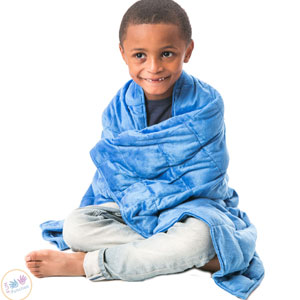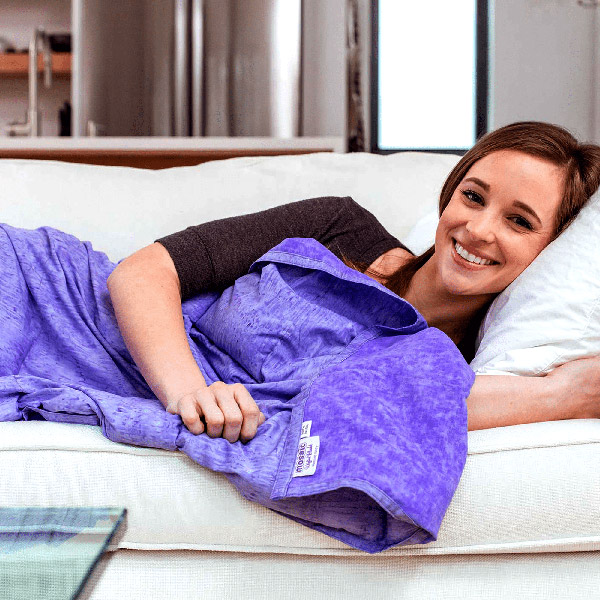A Weighted Blanket that Stays Cool? How to Know if It’ll Be Too Hot for You
For transparency, I wanted to let you know that this page contains affiliate links. What is an affiliate link? In a nutshell, as an Amazon and Shareasale affiliate if you make a purchase after clicking a link on this site, I may receive a small commission, at absolutely no extra cost to you! Why do I have affiliate links on my site? Running a site like this and producing quality free content can be surprisingly time and resource intensive. Earning some affiliate income allows me to offset and justify the time and cost involved in producing content, paying for hosting, maintaining the site etc.
If you are considering a weighted product for yourself, a friend, family member or child: Please make sure you are well educated on the right weight to use, and whether use of a weighted product would be safe in your specific situation. If you are at all uncertain, please consult a qualified medical practitioner. Material provided on this site is for general informational purposes only and should not be considered a substitute for qualified medical advice (more info about that here).
It’s natural for you to have this thought process. After all, adding weight and thickness to a blanket will obviously increase the temperature, or will it? Is there a weighted blanket that stays cool, even in the hottest weathers?
I’ve done some research into this subject and here is what I’ve found.
Are Weighted Blankets too Hot for the Summer?
Possibly. I don’t say this to put you off weighted blankets, but merely so you’re more aware of the choices you make.
If you choose a fabric that is dense, warm and airtight like knitted polyester, thick denim, flannel, woven acrylic or fleece, basically anything synthetic, you can be sure that your heavy blanket could possibly be hot, especially in summer.
And if you live in a hot weather location, I'd advise staying away from buying blankets made of those fabrics.
And what if you already have a heavy blanket that’s feeling too warm?
Well, luckily for you, there are other things you could do to keep yourself cool when using your blanket such as:
- Decrease the temperature of your surroundings (increase the airflow with a fan or by turning up the air-conditioning).
- Drink cold or icy beverages and obviously a lot of water- this alone will help regulate your body temperature and keep you cool.
- Take a cold shower before climbing in underneath your blanket.
- Wear breathable clothing (or none).
- Turn off any heat producing appliances.
Having mentioned all this, I’ll also delve into some fabric options to get a weighted blanket that stays cool later in this article, so keep reading.
Will your weighted blanket make you sweat?
This is quite a personal issue. If you are the type of person who is prone to sweating during the night, then unfortunately yes, you will perspire but purely because that is your natural predisposition.
In hot and moist climates, a weighted blanket will propably make you sweat, given the fact that the blanket will create an enclosed space with you in it, which will allow the humidity to take over. In these cases, there really is no way to prevent it.
If, however, you don’t usually sweat during your sleep cycle, you should be fine.
These blankets are designed to add a lot of weight, not a lot of heat, so that if the climate where you live allows it, you’ll be fine most of the times.
But as we’ll discover today, you can choose a fabric that is cooler, in order to maintain your level of comfort.
What about cold nights? Will they be warm enough in cold weathers?
As I said before, weighted blankets are not for warming you, so in lower temperatures, you’ll be better using an additional quilt under(or over) the heavier one, that way you’ll be nice, warm and snug under the sheets during winter months.
Your normal body temperature will see to that, unless of course, you are using one of the cooler fabrics and just regular silk sheets underneath it, then you may want to add a little something for extra comfort if the weather is too chilly.
How are the fabric and fillers related to the temperature under the blanket?
There definitely is a correlation between the fabric and the fillers used, when it comes to how warm it can get when you sleep under the blanket.
Remember that it’s mainly body heat that gets trapped by the fabric under the blanket that causes your body to swelter.
In the case of fillers though, I can tell you that, for some reason, sands seem to be one the materials taking more heat from us and retaining it.
Almost all of the organic fillers will absorb and conduct heat very effectively, so it’s important to choose your filler wisely if you want to use your heavy blanket in summer or if you’re a person who simply runs hot.
Glass beads and plastic pellets are inorganic fillers and are not able to conduct heat the way sand would, and are therefore much cooler. According to my research, plastic pellets turned out to be the least insulating filler.
Now, you can think for yourself that heavy heat-trapping fabrics that are staples for clothing in winter like wool (which wouldn’t really be ideal for this purpose, but I’ll mention it anyway) would naturally be hot, itchy and uncomfortable.
Also, if there is any additional padding added to your blanket or adding a cover to it, it will definitely make it much warmer than without it.
If you're considering purchasing a weighted blanket, these are some popular options:
Image | Name | Fabric | Filler | Decorations | Prices & Details |
|---|---|---|---|---|---|
Moonbow | Bamboo and polyester | Micro Glass beads | 2 colors | ||
Fun and Function | Soft Plush cotton / polyester | Polypropylene pellets | 1 color | ||
Luxome | Ultra plush minky or luxury bamboo | Glass beads (certified lead free) | Many colours available | ||
Mosaic Weighted Blankets | Cotton, minky and textured fabric choices | FDA compliant plastic pellets | Widest range of colors and patterns |
What about the size?
The size of your blanket however, really won’t have any bearing on temperature other than depending on how big it is and whether or not a portion of your body is exposed.
If, for example, your feet stick out, they’d be a bit colder than the rest of your person that is covered under the blanket.
As a matter of interest, keep in mind that the weight of your blanket should come from the filler and not the fabric, this will also ensure you don’t get any warmer than you should.
The coolest fabric options for weighted blankets
The best option for a cooler weighted blanket is a fabric that is organic or semi-organic and naturally cool to the touch.
What do I mean, you ask?
Think about this scenario, you’re in the department store and you see a beautiful bedding display. You run your fingers over the material and you can just feel the cooler undertone. You can practically sense the air rushing through the fibers, and you just know you’re going to be comfortable under that duvet.
Now, on the same display is a fluffy fleecy blanket thrown over the edge of the make shift bed, and even just looking at it you know you’re going to be warm and snug underneath it, you touch it too and you instantly experience the comfort and warmth.
That, people, is what I’m talking about. And you can easily spot these differences when looking at the fabrics used by many manufacturers.
But enough storytelling, let me get to the point of fabrics now.
My favorite low-heat material choices are:
- High quality 100% cotton- by far the absolute best choice. I also love the crispy but not scratchiness of this fabric.
- Silk cotton blends- not only cool but smooth to the touch too.
- Cotton with polyester blend (the majority of your blend should be cotton though)
Final thoughts
Well, other than materials and fillers, your choice of blanket combination will certainly have an effect on heat levels.
If, for example, you put a regular fleece blanket underneath your weighted quilt, you’ll prevent air from flowing freely, trapping it between you and the covers.
This could cause you to overheat, so keep that in mind.
It may be best to simply have a regular sheet under your heavy blanket rather than other duvets or covers.
So, you see it’s all relevant. You can find solutions to most of the problems you may come across when using a weighted blanket.
And with that, I’m at the end of the story.
I hope I’ve answered all your questions and that you’ve found this information helpful.
You should now be able to go out and choose the best weighted blanket for your needs.





